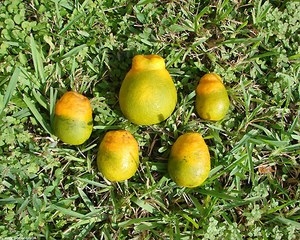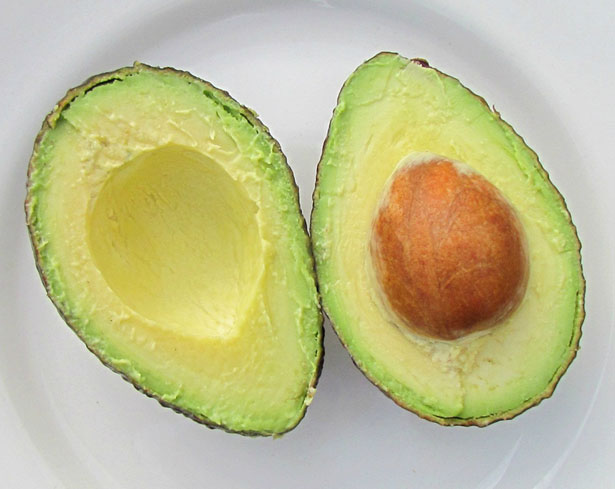
Posts Tagged: quarantine
What Happens in a Quarantine?
The recent find of an infected adult Asian citrus psyllid in Santa Paula prompted the search for the potentially infected tree by CA Department of Food and Agriculture personnel to spread out to look and test. Two trees were found and presumably they will be destroyed. This now prompts a much more intense survey of the surrounding 2/10ths of a mile of those trees. It also places a quarantine on the movement of fruit out of that area, extending out 5 miles. That means no fruit or plant parts should be taken out of the area, potentially spreading the insects and disease to other areas, unless those plant parts have been properly treated. You can read more about the actions taken in a quarantine when infected insects or plants are found HERE . And in this document you can read about the details in and around a quarantined area and how the fruit and plants should be treated HERE.
As is the case in the spread of many invasive pests, it is humans that can be the main mode of movement of the pest and disease.

ACP nymphs sam droege
Detection of HLB In Ventura - Quarantine
|

hlb defprmed citrus
Importation of Spanish Avocados
APHIS is proposing to amend its fruits and vegetables regulations to allow the importation of avocados from continental Spain into the United States. (This proposal does not include avocados from the Balearic Islands or the Canary Islands.)
As a condition of entry, avocados from Spain would have to be produced in accordance with a systems approach that would include requirements for importation in commercial consignments; registration and monitoring of places of production and packinghouses; grove sanitation; and inspection for quarantine pests by the national plant protection organization of Spain.
Consignments of avocados other than the Hass variety would also have to be treated for the Mediterranean fruit fly (Medfly) either prior to moving to the United States or upon arrival prior to release. Consignments would also be required to be accompanied by a phytosanitary certificate with an additional declaration stating that the avocados were grown and inspected and found to be free of pests in accordance with the proposed requirements.
This action would allow for the importation of avocados from Spain into the United States while continuing to provide protection against the introduction of quarantine pests.
We will consider all comments that we receive on or before April 1, 2013.
You may submit comments by either of the following methods:
- Federal eRulemaking Portal: Go to http://www.regulations.gov/#!documentDetail;D=APHIS-2012-0002-0001
- Postal Mail/Commercial Delivery: Send your comment to
Docket No. APHIS-2012-0002
Regulatory Analysis and Development
APHIS PPD Station 3A-03.8
4700 River Road Unit 118
Riverdale, MD 20737-1238
Supporting documents and any comments we receive on this docket may be viewed at http://www.regulations.gov/#!documentDetail;D=APHIS-2012-0002-0001 or in our reading room, which is located in room 1141 of the USDA South Building, 14th Street and Independence Avenue SW., Washington, DC. Normal reading room hours are 8 a.m. to 4:30 p.m., Monday through Friday, except holidays. To be sure someone is there to help you, please call (202) 799-7039 before coming.


avocado fruits
Central Valley ACP Quarantine Area Expands
SACRAMENTO — An additional portion of Fresno County along its southern border with Tulare County has been placed under quarantine for the Asian citrus psyllid (ACP) following the detections of ACP in two locations in an unincorporated area of northern Tulare County near the City of Orange Cove. The quarantine expansion adds approximately 50 square miles to the existing quarantine for a total of 84 square miles in Fresno County. All of Tulare County remains under quarantine as a result of previous ACP detections.
The new quarantine area in Fresno County is bordered on the north by E Kings Canyon Road; on the south by the Fresno County Boundary Line; on the west by S Alta Avenue; and on the east by an unnamed creek. The quarantine map is available online at www.cdfa.ca.gov/plant/go/acp-qmaps.
The quarantine prohibits the movement of citrus and curry tree nursery stock out of the quarantine area and requires that all citrus fruit be free from ACP prior to moving out of the quarantine area. An exception may be made for nursery stock and budwood grown in USDA-approved structures which are designed to keep ACP and other insects out. Residents with backyard citrus trees in the quarantine area are asked not to transport citrus fruit or leaves, potted citrus trees, or curry leaves from the quarantine area.
ACP county-wide quarantines are now in place in Imperial, Los Angeles, Orange, Riverside, San Bernardino, San Diego, Santa Barbara, Tulare and Ventura counties, with portions of Fresno, Kern, Madera, San Joaquin, San Luis Obispo, and Santa Clara counties also under quarantine.
The ACP is an invasive species of grave concern because it can carry the disease huanglongbing (HLB), also known as citrus greening. All citrus and closely related species, such as curry trees, are susceptible hosts for both the insect and disease. There is no cure once a tree becomes infected; the diseased tree will decline in health and produce bitter, misshaped fruit until it dies. HLB has been detected just once in California – in 2012 on a single residential property in Hacienda Heights, Los Angeles County. This plant disease does not affect human health.
Residents in the area who think they may have seen ACP or symptoms of HLB on their citrus trees are urged to call CDFA's Invasive Species Hotline at 1-800-491-18991-800-491-1899 FREE. For more information on the ACP and HLB, please visit: www.cdfa.ca.gov/go/acp.
—California Department of Food and Agriculture

ACP adult and nymph
